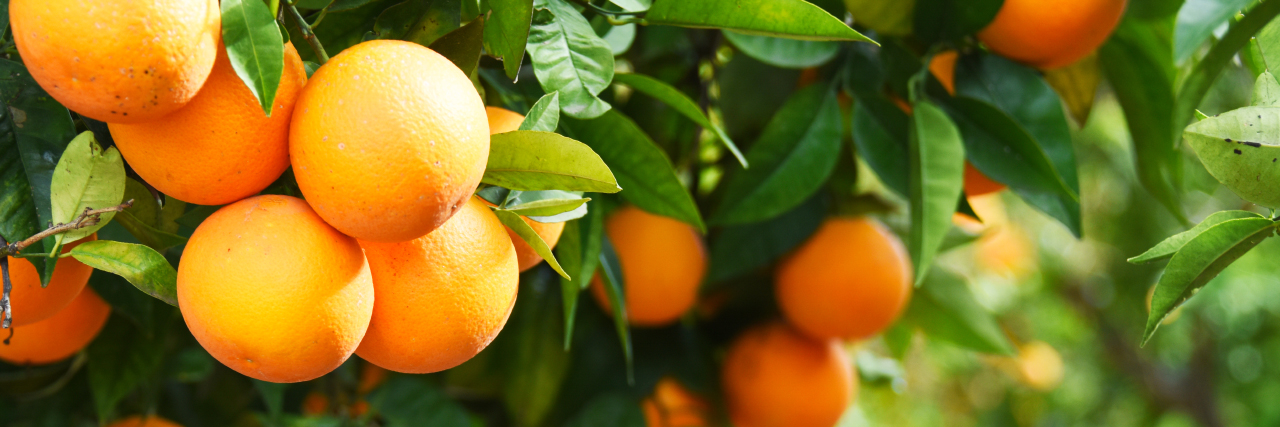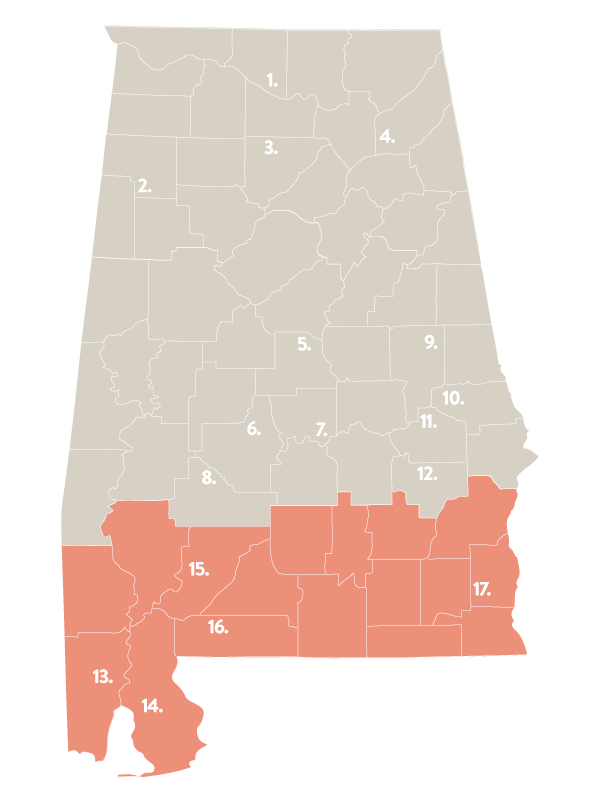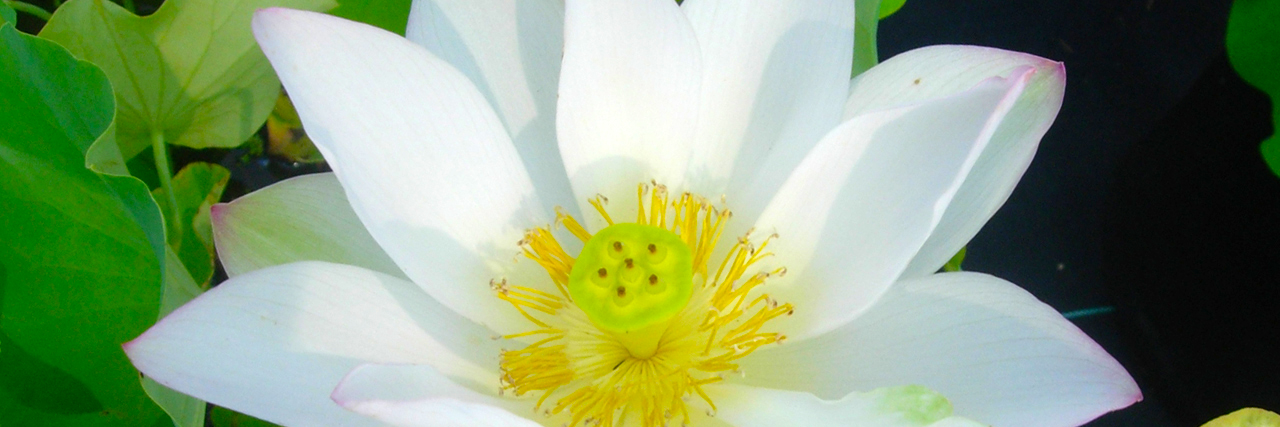
South Region
Alabama Research Units
13. Ornamental Horticulture Research Center (OHRC)
14. Gulf Coast Research and Extension Center (GCREC)
15. Monroeville Experiment Field (MEF)
16. Brewton Agricultural Research Unit (BARU)
17. Wiregrass Research and Extension Center (WREC)

ORNAMENTAL HORTICULTURE RESEARCH CENTER
Spring Hill, AL — The Ornamental Horticulture Research Center (OHRC) in Mobile is located in an area of Alabama where commercial nurseries abound, and that’s an ideal site for an applied-research facility dedicated primarily to supporting the commercial container-nursery industry. Research at the OHRC focuses on helping producers identify and address pest, disease and other production problems. Located in an urban setting, at 17 acres, the OHRC is the smallest among the Alabama Ag Experiment Station’s outlying units.

AREAS OF RESEARCH
NURSERY PRODUCTION
- Use of night-interrupted light for perennial plant production
- Alternative media (various forestry products) as a supplement or replacement for pine bark in woody ornamental production
- Controlled release fertilizer evaluations
DISEASE AND INSECT PEST MANAGEMENT
- Spray trials for leaf spot diseases
- Boxwood anthracnose control and etiology
- Water temperature manipulation for hydroponic lettuce production
- Etiology of Loropetalum gall disease
HISTORY
The Spring Hill Ornamental Horticulture Substation (now the Ornamental Horticulture Research Center) can trace its beginnings to 1928 when an Alabama Agricultural Experiment Station entomologist was sent to Mobile to help Satsuma producers combat citrus pests. Work at the substation was gradually expanded to include azalea and camellia insects.
In 1945 Auburn severed its ties to the unit, but six years later in response to a severe freeze in 1950 and to grower needs, Alabama legislation funded restaffing of the field station.
Disease and insect control for ornamentals has been the major thrust for research at the station, but other aspects of nursery production have also been studied through the years.
At 18 acres, the OHRC is the smallest among the Alabama Ag Experiment Station’s outlying units. The substation was originally established on four acres near Mobile. In 1930 the city of Mobile deeded seven acres to Auburn University and in 1965 seven additional acres were deeded from Mobile to the station.
How Can I Get a Soil Test Kit?
Please contact us at 251-342-2366 or contact your local county extension office.
Can I Get A Tour Of The Research Center?
The OHRC is not open for daily tours. However, depending on the season and available personnel, anyone can call to arrange an appointment for a quick tour. If you have specific questions about a project or problem, contact us at 251-342-2366. We will make an appointment to discuss it.
OHRC Weather
Contact
Ornamental Horticulture Research Center
P.O. Box 8276
411 North McGregor Ave.
Mobile, AL 36689
+1 (251) 342-2366
Directions
OFFICE HOURS
Monday — Friday
GULF COAST RESEARCH & EXTENSION CENTER
Fairhope, AL — With its location one mile east of Mobile Bay and 30 miles north of the Gulf of Mexico, the Gulf Coast Research and Extension Center in Fairhope enjoys a climate that’s ideal for a highly diversified research program, and the GCREC takes full advantage of that. The long growing seasons and mostly mild winters allow for research on all of Alabama’s major row crops as well as on turfgrass, vegetable and fruit crops, pecans, beef cattle and forage. The GCREC’s top goal is to help southwest Alabama producers maximize their income.
AREAS OF RESEARCH
-
Beef Cattle – Herd Management
-
Cotton – Integrated Pest Management
-
Peanuts – Disease Management
-
Corn – Agronomic and Disease Management
-
Soybean – Integrated Pest Management
-
Pecan – Variety evaluation and disease management
-
Variety Evaluations – Corn, Cotton, Peanut, Soybeans, Citrus, Small Fruit and Small Grains
HISTORY
The Gulf Coast Research and Extension Center (formerly known as the Gulf Coast Substation) began operating in 1930 at Fairhope, Ala. Research on seed potatoes obtained from the Midwest served as the primary focus for the substation researchers during the early years. Efforts to increase the phosphorus content of newly cleared acreage also received attention.
Research on other horticultural crops, agronomic field and forage crops and dairy and beef cattle was implemented later. A lagoon waste management and wastewater recycling system in connection with the dairy unit was added in the late 1970s.
The Gulf Coast Substation was one of the first five substations established in Alabama by the legislature to create research facilities in five main areas of the State: Tennessee Valley, Sand Mountain, Black Belt, Wiregrass and Gulf Coast. Three of the five went into operation in 1929: The Tennessee Valley Substation at Belle Mina, the Sand Mountain Substation at Crossville and the Wiregrass Substation at Headland. The remaining two, the Black Belt Substation at Marion Junction and the Gulf Coast Substation at Fairhope, began operating in 1930.
Gulf Coast REC Weather
Contact
Gulf Coast Research & Extension Center
8300 State Highway 104
Fairhope, AL 36532
+1 (251) 928-2740
Directions
OFFICE HOURS
Monday — Friday
Facilities
Brewton Agricultural Research Unit
Brewton, AL — At the Brewton Agricultural Research Unit, the research emphasis is ever changing to meet the needs of researchers and producers. With its sandy soils it is an ideal location for nematode research in several crops such as peanuts, cotton, and vegetables. There is a long term fertility study that can provide information on how different levels of nutrients effect the performance of various crops. The center also is involved in bioenergy research, with studies on switchgrass, bluestem and sorghum for use in biofuels. Past research has focused on ornamental crops and some of this research continues.

AREAS OF RESEARCH
-
BIOBASED PRODUCTS AND PROCESSING – Growing bioenergy crops.
-
ORNAMENTAL HORTICULTURE/NURSERY CROPS – Crape myrtle breeding program; evaluation of nitrogen rates and timing of fungicide treatments on shrub roses, hydrangea and crape myrtles; disease control studies; variety evaluations.
-
VARIETY EVALUATIONS – Corn, small grain, soybeans.
-
VEGETABLES, FRUITS AND BERRIES – Nematode control; variety evaluations on tomatoes, peppers, squash, leaf lettuce, leafy greens and southern peas.
HISTORY
The Brewton Agricultural Research Unit (formerly known as the Brewton Experiment Field) was established by 1930 and administered by the Department of Agronomy and Soils until the mid-1960s. The unit began as a small field primarily for soil fertility research for agronomic crops on this particular soil type (Benndale fine sandy loam). During the last 25 years, the unit has become more involved with horticultural research with research on small fruits, vegetables, flowering annuals, woody ornamentals and some agronomic crops.
Brewton Experiment Field was one of ten experiment fields established and in operation by 1930 on tracts ranging from 33 to 60 acres in size. Of these ten, three remain in service today: Brewton Experiment Field, Monroeville Experiment Field and Prattville Experiment Field.
Brewton Weather
Contact
Brewton Agricultural Research Unit
P.O. Box 217
2067 Kirkland Road
Brewton, AL 36426
+ 1 (251) 867-3139
Directions
OFFICE HOURS
Monday — Friday
Facilities
Wiregrass Research & Extension Center
Headland, AL — A variety of soil types and land characteristics typical of the Coastal Plain allow the Wiregrass Research and Extension Center (WREC) to address problems that challenge farmers in this region. While the center has been a leader in all types of agronomic research, it is renown for its focus on peanuts.

AREAS OF RESEARCH
-
PEANUTS – A twenty-one year old ongoing crop rotation study centered around peanuts.
-
CATTLE – Grassfed beef research utilizing multiple forage species.
-
VARIETY EVALUATIONS – Field and forage crops, including peanuts, cotton, corn, small grain.
HISTORY
The Wiregrass Substation (now known as the Wiregrass Research and Extension Center) was founded in 1929 at Headland, Ala. Early work concentrated on cotton and corn, the traditional crops of the region, but the peanut crop soon began to absorb most of the research work at the station.
After WWII farmers in the southeastern portion of Alabama steadily turned toward the cultivation of peanut as it became the primary cash crop in the region. AAES researchers used the Wiregrass land to address a host of problems associated with peanut production, including mechanical harvesting studies that reduced labor requirements for successful cultivation from 30 hours to only four hours per acre.
During the 1950s and 1960s areas of peanut research included mechanization, insect and disease control, storage and marketing. An extensive peanut storage project was conducted to provide information for farmers, peanut handlers, and warehousemen on maintaining peanut quality during storage. Also during these decades work was conducted on mechanizing cotton harvest.
A study in the 1980s found that the seeding rate for peanuts could be reduced without a significant reduction in yield or net returns.
The foundation peanut seed organization is currently handled at Wiregrass.
The Wiregrass Substation was one of the first five substations established in Alabama by the legislature to create research facilities in five main areas of the State: Tennessee Valley, Sand Mountain, Black Belt, Wiregrass and Gulf Coast. Three of the five went into operation in 1929: The Tennessee Valley Substation at Belle Mina, the Sand Mountain Substation at Crossville, and the Wiregrass Substation at Headland. The remaining two, the Black Belt Substation at Marion Junction and the Gulf Coast Substation at Fairhope, began operating in 1930.
Contact
Wiregrass Research & Extension Center
167 East Alabama Highway 134
Headland, AL 36345
+1 (334) 693-2363
Directions
OFFICE HOURS
Monday — Friday
Facilities

